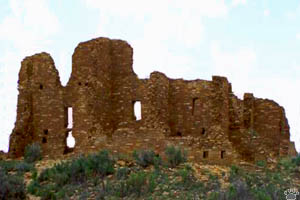
Pueblo Pintado ruins, New Mexico.
The Old New Mexico - Part 2
The Ancient Puebloan culture reached its peak in 800-1200 AD,
when dozens of colossal, even labyrinthine, one-house cities were built in Chaco
Canyon and other places in northwestern New Mexico and adjacent parts of Colorado
and Arizona.
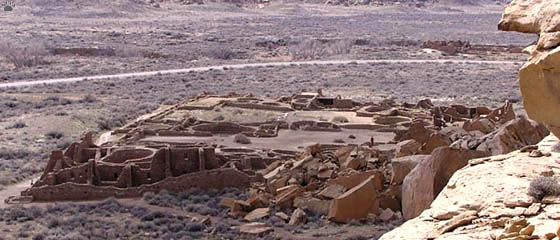 Lone tourist in Pueblo Bonito ruins, Chaco Canyon National Historic
Park , New Mexico.
Lone tourist in Pueblo Bonito ruins, Chaco Canyon National Historic
Park , New Mexico. |
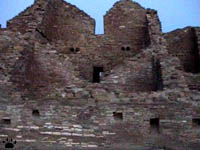
Chaco Canyon has the tallest pre-Colombian
structures north from Central Mexico. |
The Ancient Puebloan culture reached
its peak in 800-1200 AD, when dozens of colossal, even labyrinthine, one-house
cities were built in Chaco Canyon and other places in northwestern New Mexico. |
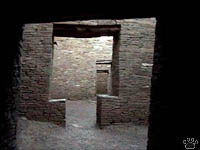
Some houses in Chaco Canyon have
five stores and more than a hundred rooms. |
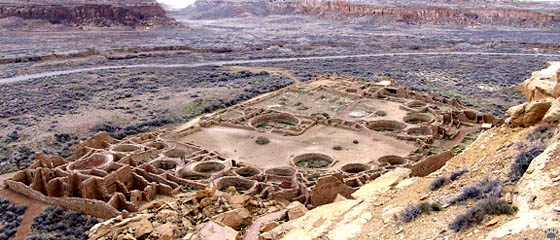 Pueblo Bonito in Chaco Canyon.
Pueblo Bonito in Chaco Canyon. |
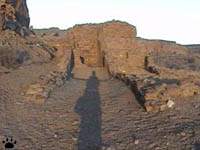
Spring equinox sunset, Chaco. Some structures
are aligned with rare and little-known celestial
events, such as the northernmost moonrise,
which occurs only once in eighteen years. |
These cities are famous for unbelievable
complexity of planning. Sometimes outer walls in cities separated by many miles
of deserts and high mountains are in perfect alignment. The largest cities were
usually shaped as semicircles, at least in Chaco area. |

Some walls in Chaco form direct lines with walls
at Pueblo Pintado, another Ancient Puebloan
center 32 km/20 miles to the east Many such
alignments are yet to be discovered. |
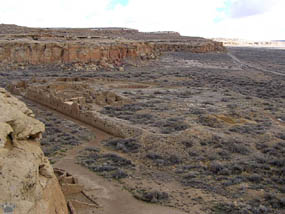 |
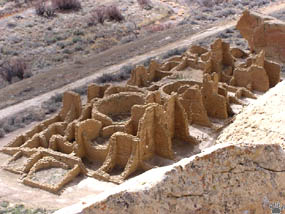 |
| Chetro Ketl (left) and Kin Kletso
ruins, Chaco Canyon. |
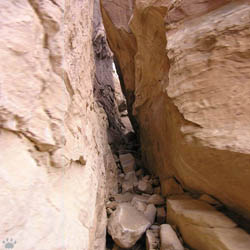
Secret path to Pueblo Alto city, Chaco Canyon. |
An extensive road network once connected
all those cities, while sacred sites were scattered around them. |
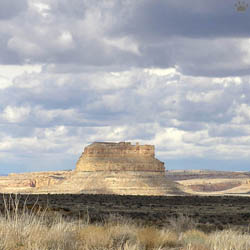
Fajada Butte, a sacred rock at the entrance to Chaco Canyon. |
 One of the Great Kivas, Chaco Canyon Nat'l Monument.
One of the Great Kivas, Chaco Canyon Nat'l Monument. |

Kivas, Chaco Canyon, New Mexico. |
The Ancient Puebloans also built rounded
pit houses called kivas. Reminiscent of Neolithic dwellings, kivas served
as places of religious gatherings, symbols of connection with the past. |
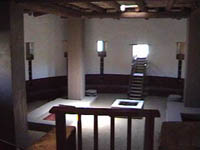
Reconstructed kiva, Aztec Ruins. |
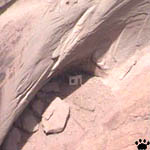 |
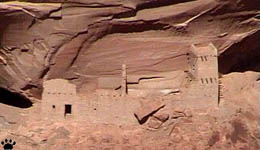 |
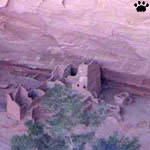 |
| Ancient Puebloan settlements hidden
in the vertical cliffs of Canyon de Chelly, Arizona. |

Frijoles Canyon hides ancient ruins
in Bandelier Nat'l Monument. |
Later, frequent attacks by other tribes forced
the Ancient Puebloans into remote canyons, where they built spectacular cliff
towns. Then they moved away. Their descendants are the Hopi of Arizona and the
Pueblo Indians of New Mexico. |

Cliff pueblo, Mesa Verde Nat'l
Monument , Colorado. |
 View of Canyon de Chelly, Arizona. A small Ancient Puebloan structure
is hidden at the base of the tall rock in the center.
View of Canyon de Chelly, Arizona. A small Ancient Puebloan structure
is hidden at the base of the tall rock in the center. |
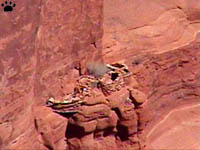
Ancient Puebloan structure, Canyon de Chelly. |
The Mogollon and Ancient Puebloan lands
were eventually taken over by semi-nomadic tribes from the North - the Apaches
and the Navajo, respectively. They didn't build much, but their art was also interesting. |

House on a cliff, Canyon de Chelly. |
 |
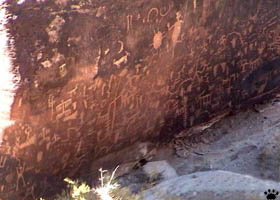 |
| Newspaper Rock, Petrified Forest
National Monument, Arizona. |

Newspaper Rock, near Canyonlands National
Park , Utah. |
The Navajo created some of the most impressive
rock art in the region.

Pictograph, Canyon de Chelly. |
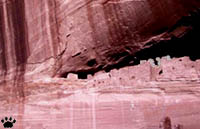
Ancient Puebloan village later renovated and
re-inhabited by the Navajo, Canyon de Chelly. |
 Pictograph showing Spanish soldiers, Canyon de Chelly.
Pictograph showing Spanish soldiers, Canyon de Chelly. |

Ancient Puebloan and Navajo masonry side by
side, Chaco Canyon. |
The Navajos also learned to build stone
structure. But their masonry was completely different from Anasazi styles. They
didn't use mortar, and their structures were almost always circular rather then
rectangular. |
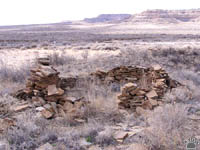
Ancient Navajo ruins, probably 17-18
century, Chaco Canyon. |
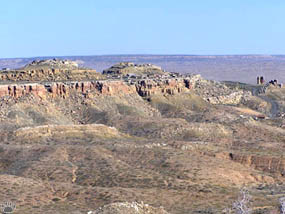 |
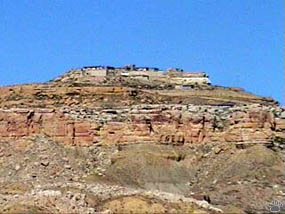 |
| Second Mesa, a hilltop village
in Hopi Reservation, Arizona. |

Old Oraibi, the oldest village of Hopi Reservation. |
As for the Ancient Puebloans, there
descendants are the Hopi of Arizona and the present-day Pueblo Indians of New
Mexico. |

Old Oraibi, the oldest village of Hopi Reservation. |
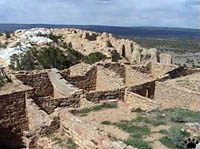
Pueblo ruins, El Morro Nat'l Monument. |
Part 3
Back to Part 1
Home
|